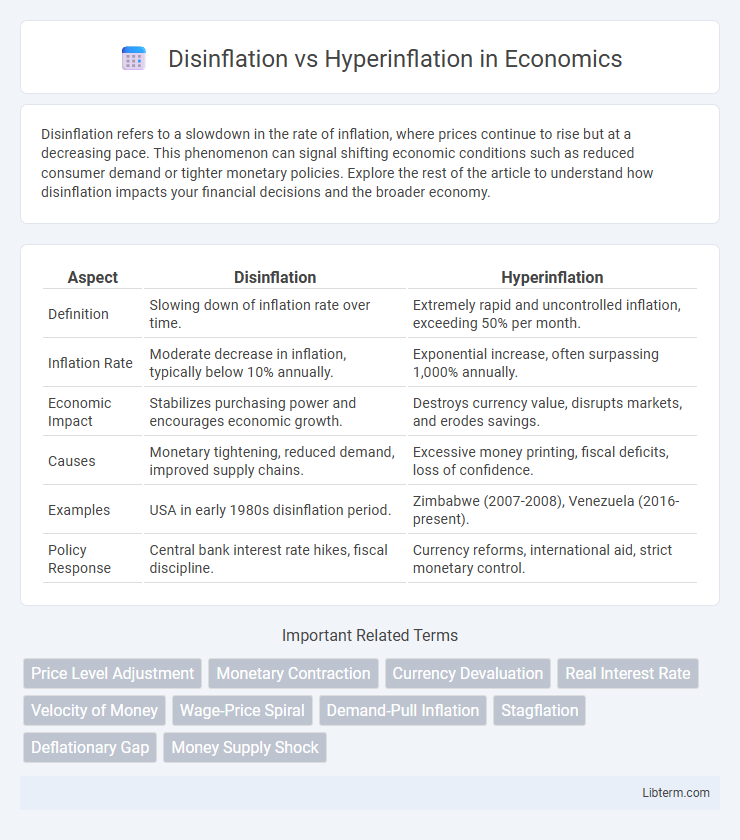Disinflation refers to a slowdown in the rate of inflation, where prices continue to rise but at a decreasing pace. This phenomenon can signal shifting economic conditions such as reduced consumer demand or tighter monetary policies. Explore the rest of the article to understand how disinflation impacts your financial decisions and the broader economy.
Table of Comparison
| Aspect | Disinflation | Hyperinflation |
|---|---|---|
| Definition | Slowing down of inflation rate over time. | Extremely rapid and uncontrolled inflation, exceeding 50% per month. |
| Inflation Rate | Moderate decrease in inflation, typically below 10% annually. | Exponential increase, often surpassing 1,000% annually. |
| Economic Impact | Stabilizes purchasing power and encourages economic growth. | Destroys currency value, disrupts markets, and erodes savings. |
| Causes | Monetary tightening, reduced demand, improved supply chains. | Excessive money printing, fiscal deficits, loss of confidence. |
| Examples | USA in early 1980s disinflation period. | Zimbabwe (2007-2008), Venezuela (2016-present). |
| Policy Response | Central bank interest rate hikes, fiscal discipline. | Currency reforms, international aid, strict monetary control. |
Introduction to Disinflation and Hyperinflation
Disinflation refers to a slowdown in the rate of inflation, where prices continue to rise but at a decreasing pace, indicating a stabilizing economy. Hyperinflation is an extreme and rapid increase in prices, often exceeding 50% per month, leading to a collapse in currency value and severe economic instability. Understanding these phenomena helps economists gauge the severity of inflationary pressures and guide monetary policy decisions effectively.
Definitions: Disinflation vs Hyperinflation
Disinflation refers to a slowdown in the rate of inflation, indicating that prices are rising at a decreasing pace. Hyperinflation is an extremely rapid and out-of-control price increase, typically exceeding 50% per month, causing severe economic instability. While disinflation signals a cooling of inflationary pressures, hyperinflation reflects a complete loss of currency value.
Key Economic Indicators
Disinflation is characterized by a decreasing rate of inflation, often reflected in slowing consumer price index (CPI) growth and stabilizing wage increases, signaling controlled economic expansion. Hyperinflation features an extreme and rapid rise in prices, with CPI soaring at rates exceeding 50% per month, eroding purchasing power and causing currency devaluation. Key economic indicators distinguishing these phenomena include inflation rate trends, money supply growth (M2), velocity of money, and changes in real GDP, which collectively highlight economic stability in disinflation and volatility in hyperinflation.
Causes of Disinflation
Disinflation occurs when the inflation rate slows down but remains positive, often caused by tightened monetary policies such as higher interest rates that reduce consumer spending and borrowing. It can also result from decreased demand due to economic recessions or increased supply through technological advancements and productivity gains. In contrast to hyperinflation, which stems from excessive money printing and loss of confidence in currency, disinflation reflects controlled and moderate adjustments in price increases.
Triggers of Hyperinflation
Hyperinflation is primarily triggered by excessive money supply growth often resulting from government deficit financing without corresponding economic output, leading to a rapid loss of currency value. Other factors include loss of confidence in the currency due to political instability, supply shocks, or dramatic increases in demand relative to supply. Unlike disinflation, which involves a slowdown in inflation rates, hyperinflation represents an uncontrollable surge in prices driven by these destabilizing triggers.
Economic Impacts and Consequences
Disinflation, characterized by a gradual decrease in inflation rates, stabilizes purchasing power and supports sustained economic growth by preventing excessive price volatility. Hyperinflation causes extreme currency devaluation, eroding savings, disrupting markets, and leading to severe economic instability and reduced consumer confidence. The economic consequences of disinflation promote investment and long-term planning, while hyperinflation triggers social unrest, loss of monetary control, and a collapse in fiscal discipline.
Historical Examples and Case Studies
Disinflation refers to a slowdown in the rate of inflation, exemplified by the U.S. experience during the 1980s under Federal Reserve Chair Paul Volcker, who implemented tight monetary policies to reduce runaway inflation from nearly 15% in 1980 to under 4% by 1983 without triggering a recession. Hyperinflation, characterized by monthly inflation rates exceeding 50%, devastated the Weimar Republic in the early 1920s, with prices doubling every few days, and more recently Zimbabwe in the late 2000s, where annual inflation peaked at 89.7 sextillion percent, collapsing the economy and causing widespread currency abandonment. These case studies highlight contrasting monetary phenomena: controlled deceleration of inflation preserving economic stability versus catastrophic currency devaluation resulting in lost savings and economic paralysis.
Policy Responses and Management Strategies
Disinflation requires central banks to cautiously adjust interest rates and tighten monetary policy to gradually reduce inflation without triggering a recession. In contrast, hyperinflation demands aggressive fiscal consolidation, often including currency reforms and price controls, alongside restoring public trust in the government's economic stability. Effective management of hyperinflation typically involves coordinated international support and structural economic reforms to stabilize the currency and control excessive money supply.
Disinflation vs Hyperinflation: Comparative Analysis
Disinflation refers to a slowdown in the rate of inflation where prices continue to rise but at a decreasing pace, often signaling stabilizing economic conditions. Hyperinflation is characterized by extremely rapid and uncontrollable price increases, typically exceeding 50% per month, leading to severe currency devaluation. The comparative analysis highlights that disinflation indicates a transitioning economy toward price stability, whereas hyperinflation represents a breakdown in monetary policy and economic confidence, causing drastic losses in purchasing power.
Future Outlook and Lessons Learned
Disinflation signals a slowdown in inflation rates, indicating potential stabilization in an economy's price levels and improved monetary policy effectiveness, which can foster investor confidence and sustainable growth. Hyperinflation, characterized by rapid and uncontrolled price increases often exceeding 50% per month, reveals the catastrophic impacts of fiscal mismanagement, loss of currency value, and social instability, emphasizing the need for credible central banking and strict fiscal discipline. Lessons learned underscore that proactive monetary policy, transparent governance, and inflation targeting are critical for avoiding hyperinflation's destructive economic consequences and ensuring a stable economic future.
Disinflation Infographic

 libterm.com
libterm.com